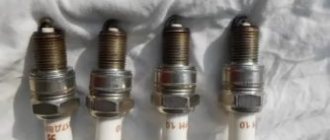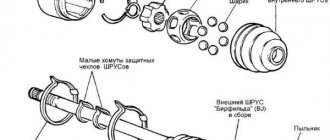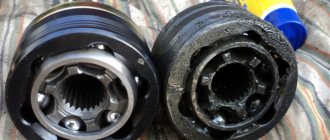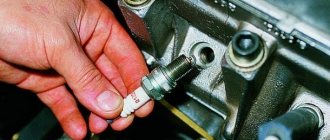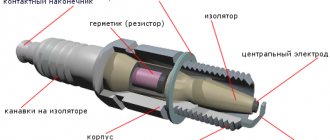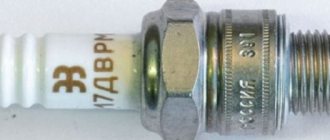September 16, 2018
In general, replacing spark plugs yourself is not difficult, but you need to know exactly how to carry out this procedure. The article will be useful, first of all, for car enthusiasts without experience in vehicle maintenance.
Spark plugs in a car are used to ignite the fuel-air mixture in a heat engine. Damage to the spark plugs causes the mixture to ignite worse, the engine loses its power, ignites and detonates. Detonation is the untimely or spontaneous ignition of the mixture in the combustion chamber, accompanied by popping sounds and the appearance of a shock wave. Gradually, the combustion chamber becomes clogged and becomes covered with soot and combustion products of the mixture. As a result, the engine as a whole wears out.
Description of the location of the car's spark plugs
They are located in the so-called spark plug well, mounted in the cylinder block.
On one side, the spark plug is connected to the high voltage ignition conductor. This part may be located above the cylinder block or hidden in the spark plug well. The opposite end of the spark plug is located directly in the combustion chamber. At the right moment, an electric current arises on the electrodes, which, with the help of a spark, ignites the mixture.
The spark plug has a central electrode or may use several side conductors. The system works thanks to the distance between the central and side electrodes. This ensures sufficient operating power and spark constancy. Due to the generation of current, soot forms on the electrodes, which prevents the passage of the spark. And the electrodes themselves wear out due to intense work.
A longer service life is provided by candles with elements made of platinum or iridium. They produce less soot. Cleaning them with rags or brushes is not recommended at all, but ordinary candles need to be wiped with a dry rag or even cleaned with a wire brush, depending on the situation.
A little history
Spark plugs appeared along with the gasoline engine. Interestingly, the general concept of this element has changed little since its introduction. Of course, this element is constantly being improved, new technologies are being developed to improve its performance.
Interestingly, the first spark plugs used on cars were dismountable. This was due to the fact that the operating features of power plants of those years left much to be desired, and gasoline was not of high quality. Therefore, the spark plugs became clogged with wear products very quickly. But any auto mechanic could remove the spark plug, disassemble it, clean it, put it back in place, and it would continue to work. Non-separable spark plugs, which after stopping work were simply replaced with new ones, were proposed by G. Ford.
Required Tools
It is unlikely that it will be possible to replace spark plugs without the necessary tools. Let's figure out what we need for work.
First of all, this is a spark plug wrench, a specialized tool for removing and tightening spark plugs. Since the size of spark plugs is different for different cars, the spark plug wrench also needs to be selected. The most commonly used tool is for candles with a diameter of 16 mm, but there are exceptions. Take the time to check the features of your specific vehicle. We recommend buying a spark plug wrench with a rubber seal inside. This makes it easier to remove the candles and prevents them from falling.
In addition to the spark plug wrench, you will need a flat-head screwdriver. With its help, you can open the block cover and pry off the conductors suitable for the spark plugs.
Depending on the type of vehicle you have, socket bits may be required. Well, at the end of the list of necessary items are the spark plugs that will be required for replacement. Of course, the tool kit for your vehicle may be slightly different. However, we offer a more or less universal set for replacing spark plugs.
How to understand when it's time to replace spark plugs
The fact that the spark plugs require replacement or cleaning of carbon deposits is eloquently indicated by engine malfunction.
- He starts to trip. That is, the operation of one or more cylinders is disrupted
- Noticeable drop in engine thrust and power
- Difficulty starting the internal combustion engine. The starter is clearly working, but starting does not occur.
- An increase in the amount of carbon monoxide in the exhaust, it itself turns black
- The appearance of detonation (we already wrote about this at the beginning of the article)
The listed symptoms appear individually or in combination. Please note that replacing spark plugs with a service life of less than 10,000 km does not make sense. To restore operation, it will be enough to clean them of carbon deposits and check the contacts.
Lamps used on Renault Duster
Published: 01/29/2018
Spread the love
Spread the love Renault Duster lamp socketsContents1 Renault Duster lamp sockets1.1 Lamps used on Duster1.2 Replacing the low beam lamp of Renault Duster instructions 1.2.1 We are in vk 1 - H7 halogen lamp power 55 watts. Cylindrical in shape, with two contacts. 2 - halogen lamp H1; power 55 watts. Lamp H1 is smaller. A small glass cylinder on...
Lamps used on Renault Duster Read more »
Replacing spark plugs yourself
Let's move on to a direct description of the procedure. The work of replacing spark plugs is carried out only on a cooled engine; it is prohibited to perform the procedure “hot”!
- So, turn off the engine and let it cool.
- Next, clean the top of the cylinder block to remove debris and dust from getting inside the engine.
- Disconnect the current-carrying conductors from the spark plugs. To do this, pull them, turning them slightly in different directions.
- Remove the spark plugs using a special wrench or a ratchet with a spark plug head.
- Inspect the spark plugs and, if necessary, replace them. Let us repeat that sometimes it is enough to simply clean them with a brush or dry cloth.
Before screwing in a new set of spark plugs, be sure to wipe them with a dry cloth too. We are pursuing the same goal - avoiding debris getting into the engine. We do not recommend coating new spark plugs with oil. In this case, it will burn in the candle block. This will lead to nothing but damage to the spark plugs and engine. If the spark plugs are tight when screwed in, with resistance, then it is better to carefully unscrew them and try to screw them in again. It's possible that you just missed the thread. It is better to start tightening it gently, by hand, so as not to damage the threads for the candles. It is also better to pull with the key carefully.
Recommendations from the experts
- Even if there are indirect signs of faulty spark plugs, it is worth taking the car to a dealership or checking the spark plugs yourself, if possible. If it turns out that only one spark plug is faulty, the entire set will have to be replaced.
- If you still decide to find the reason yourself, then adhere to some rules: - all manipulations can be carried out only on a cooled engine, otherwise you can break off part of the spark plug so that it remains inside the engine; - work only with a special spark plug wrench, which has a special working area; - dismantle spark plugs only in a room free from wind, snow and other weather conditions to avoid debris getting into the cylinders; - use a compressor.
- Read the instruction manual carefully, it clearly states what kind, how many and for how long spark plugs are needed.
Why does black carbon appear on candles?
Beginning car enthusiasts, when visually inspecting spark plugs, sometimes notice black carbon deposits, what could this mean? If the soot on the electrode and threads is greasy and oily, this indicates that a lot of oil is getting into the cylinders.
The reason for this: poor condition of valve stem seals, piston rings or valve bushings. Some of the oil breaks through due to wear of the above parts. In this case, candles are not the cause, but an indicator of the problem. The candles are to blame if the soot is dry and black. It is possible that the spark is weak or compression.
If there is a velvety carbon deposit, check the pressure inside the cylinders.
In old-style gasoline engines, black carbon deposits indicate a malfunctioning carburetor. Inventory type engines thus indicate improper operation of the fuel pressure regulator. Additional reasons: over-rich mixture or clogged air filter. Do not forget, also, to replace it every 10,000 km.
Gap adjustment and diagnostics using a multimeter
When replacing spark plugs, do not forget to adjust their gap. Due to the excessive gap, the spark will begin to disappear, causing the mixture to stop igniting. If the gap on the spark plugs is small, the spark plugs are flooded with gasoline and the ignition coil may burn out.
Checking spark plugs is not necessarily carried out only according to the nature of the engine. The presence of a spark can be checked using a multimeter.
A multimeter helps determine if there is a short circuit inside the spark plug. If there is a short circuit, the spark plug can simply be replaced.
Lamps used on the Kia Spectra car
Published: 07/09/2018
Spread the love
Spread the love Used Kia Spectra lampsContents1 Used Kia Spectra lamps1.1 Replacing a Kia Spectra lamp1.2 Replacing a Kia Spectra lamp video1.2.1 We are in VK All used Kia Spectra lamps from 2000 to the present, their characteristics and visual differences. — H7 halogen lamp power 55 watts. Cylindrical in shape, with two contacts. — halogen lamp H7 power 55...
Lamps used on the Kia Spectra Read more »
Frequency of spark plug replacement
If you purchased a car at an official center, then its maintenance work still takes place according to the established technical regulations. Car manufacturers set different mileage intervals for replacing spark plugs. The most common period is between thirty-five and eighty-five thousand kilometers. There is no single clear value for replacement; a lot depends on the operating mode of the engine and the driver himself. The range of values is so large because the candles themselves have different service life. For their production, various technologies and materials are used, which gives different resistance to high temperatures and stress.
Car spark plugs are made of nickel and platinum. The first ones are changed after forty thousand kilometers, and the platinum ones will wait up to seventy thousand kilometers. The quality of iridium-coated spark plugs depends on the thickness of the electrode in the center. In general, this range is from seventy to one hundred and twenty thousand kilometers.
In general, the ideal interval for replacing spark plugs is every twenty thousand kilometers, along with an oil change. Some car owners change the oil more often. Under the operating conditions of the car in Russia, this measure is not useless.
Replacing spark plugs is not a very complicated procedure, but you need to monitor them very carefully, otherwise the engine will suffer and the car will not go anywhere else.
Useful tips on how to replace spark plugs:
These instructions will help you not only complete the replacement process correctly, but also avoid a number of possible mistakes.
- The burnt layer and dirt near the spark plug wells should under no circumstances penetrate into the combustion chamber. Remove dirt before unscrewing spent spark plugs. If dirt gets inside the wells, then do not rely on chance. It is better to blow the dirt out of the chamber using a compressor. You can also start the engine without spark plugs, as a result of which the piston will push out a portion of the fuel mixture along with dirt.
- Do not use random objects, pliers, etc. to unscrew candles. With a special key, it is easier to regulate the force for screwing in the spark plugs, plus they will not fall out thanks to magnets or rubber bands in the spark plug heads.
- Choose the correct tightening force for the spark plugs. If you over-tighten, you will damage the spark plug, and if it is not tightened properly, it will lead to poor heat dissipation. For ease of use, many manufacturers print the required values on candle packages.
It happens that the engine begins to “trouble” immediately after replacing the spark plugs. What can happen?
- A fresh or cleaned spark plug is broken
- During installation, wiring was broken or terminals were damaged.
- The contact between the terminal and the spark plug was broken
- You got confused and connected the spark plug contacts incorrectly.
- Incorrect tightening of several or one spark plug
By changing the spark plugs yourself, you can save a lot, because the price for this procedure at a service station is steep. The most important thing here is not even the experience of replacing spark plugs, but the attentiveness to identify problems in a timely manner. A tip that many people forget about, but which greatly influences the duration of use of spark plugs: use high-quality oil and fuel for your car.
Tags:
- Auto repair shop
Rate the material:
